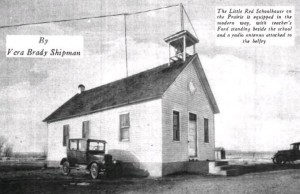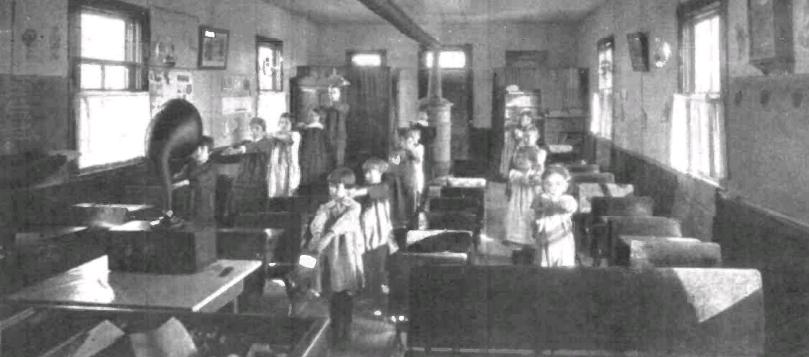Ninety years ago, radio went to school, and these Kansas schoolchildren were starting their day by doing their morning calisthenics under the direction of Mike Ahearn, athletic director of the Kansas State Agricultural College. (Ahearn carefully avoided the word “exercise,” since he knew the children had been up for hours and had walked a mile or more to school.) The same scene could be played out in any of the state’s 9000 country schools, but Ahearn was behind the microphone of the college’s radio station, KSAC in Manhattan.
 By September 1925, when these pictures appeared in Radio in the Home magazine, a good percentage of those schools had already been equipped with receivers, and plans were in place to add a radio set to all of them. In the photo shown here, the antenna is mounted to the school’s belfry, and it is powered by the teacher’s Model T parked outside.
By September 1925, when these pictures appeared in Radio in the Home magazine, a good percentage of those schools had already been equipped with receivers, and plans were in place to add a radio set to all of them. In the photo shown here, the antenna is mounted to the school’s belfry, and it is powered by the teacher’s Model T parked outside.
The college’s director of radio extension, Sam Pickard, was doing more with radio than just morning calistenics. The sets would be in place for Kansas farmers to attend statewide radio meetings of farm organizations, and they could be used on Sundays to receive church service broadcasts. Pickard’s vision for radio saw him appointed two years later by President Coolidge as one of the first five commissioners of the Federal Radio Commission.
KSAC had first come on the air on December 1, 1924, broadcasting with 500 watts on 880 kHz. In 1928, it moved to 580 kHz. In 1929, the Topeka Daily Capital wanted to start a radio station, and asked the college whether it could share the frequency. Since the college couldn’t afford to keep its station on the air 24 hours a day, it quickly came to terms, and was able to boost its power to 5000 watts to match the new station, WIBW.
By the 1980’s, the college had been known as Kansas State University for 30 years, and KSAC got around to requesting call letters that would match the University’s name. However, the call letters KKSU had been assigned to a ship, and even though the ship was mothballed, the owner wasn’t willing to relinquish them. So the station became KEXT (Kansas Extension) for a time until finally getting the KKSU call letters.
Over the years, the commercial station, had tried to buy out the college station, but the college refused. It wasn’t until 2001 that they had relented. WIBW had carried Wildcat football, and the University was planning on moving it to another station. WIBW used the opportunity to point out a clause its 1969 contract with the University. In exchange for allowing WIBW to carry the games, the college had been allowed to extend its operating hours by an additional 15 minutes each weekday. Finally, the University agreed to sell out for $1.5 million. The games would go to the other station, and KKSU would sign off for the last time in November, 2002,
Kansas wasn’t alone in putting radio receivers in the schools. Radio was already installed in schools in Cleveland, Ohio, and the superintendant predicted that within a few years, American schoolchildren would be receiving ten percent of their lessons by radio. Some of the big stations were involved. For example, KGO was broadcasting to the schools in Oakland, California, and WLS in Chicago was broadcasting “Uncle Ben” Darrow’s Little Red Schoolhouse into 150 schools in Cook County, Illinois, and was also popular at schools in Illinois, Michigan, Wisconsin, and Indiana.
Click Here For Today’s Ripley’s Believe It Or Not Cartoon ![]()

